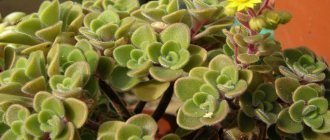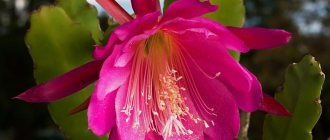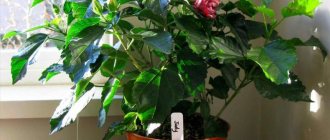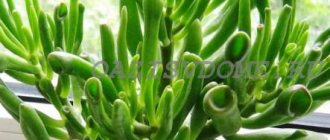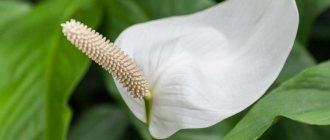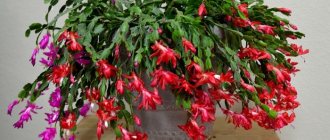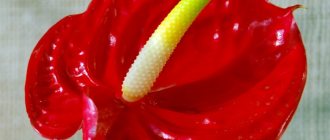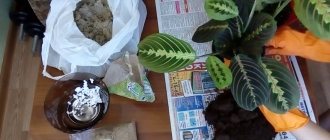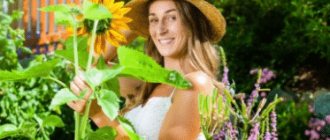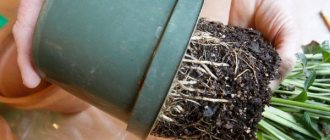|
Representatives of the bromeliad family are so diverse in appearance that sometimes it is hard to believe that they are close relatives. Take, for example, the pineapple with its tasty fruit, the aechmea with its beautiful inflorescence, or the tillandsia usneiformes, which forms thickets in the form of a long beard on the trees.
Quite unpretentious, not requiring the creation of special conditions for long-term flowering, favorite plants of phytodesigners, bromeliads are often used to decorate special events and exhibition stands. They are attracted by their inflorescences and bright leaves, which can remain decorative for several months. Compositions of bromeliads, ferns and orchids are very unusual.
To understand what conditions are needed to successfully grow bromeliads, it is useful to familiarize yourself with their growth in their natural habitat, because there are no domestic plants, but there are plants that we took from the wild and are trying to grow them.
Various natural adaptations developed during the process of evolution make it necessary to take them into account when caring for bromeliad plants. But most species grown at home require approximately the same care.
The most commonly cultivated include:
|
|
- Large-tufted pineapple - compact varieties of edible pineapple and bracted pineapple - with decorative, but inedible, fruits and variegated striped leaves.
- Billbergia drooping with a loose spike-shaped inflorescence.
- Vriesia shiny and Vriesia keeled with flat or branched spike-shaped dense inflorescences.
- Guzmania reed and Guzmania single-spike, as well as hybrid forms with bright rosette inflorescences of different shades at the top of the shoot.
- Cryptanthus are species and hybrids, cultivated for the beautiful color of their leaves, collected in a basal rosette resembling a starfish.
- Neoregelia Carolina, which turns the upper leaves red before flowering. The variegated varieties are especially beautiful.
- Nidularium Innocentia is a plant that looks similar to neoregelia.
- Tillandsia is blue with a beautiful pink-violet flat inflorescence and blue flowers that appear from the axils in turns and do not last long.
- Aechmea striped with beautiful cross-striped wide gray leaves and a soft pink inflorescence on which small brightly colored flowers open.
- Aechmea Blue Rain with unusual blue spike-shaped inflorescences, of hybrid origin.
All of these species, with the exception of pineapple, which is a terrestrial plant, lead an epiphytic lifestyle in warm and humid tropical forests, often settling in tree crevices where rotten remains of leaves accumulate. The root system of such plants is not very developed; there are feeding and anchoring roots. Plants are adapted to receive part of their nutrition and moisture from precipitation, rain and fog.
Botanical description of bromeliad
The roots of the flower are very well developed; they hold the plant very firmly in the ground. The stem is usually short, but representatives with long stems are rarely found. Bromeliad leaves are a funnel-shaped rosette. The inflorescences of the plant come in different colors and shapes. Most often they are yellow, coral or purple in color and have a racemose or paniculate shape.
Thanks to its bracted leaves, bromeliads look very elegant. Nowadays you can even find two-colored specimens of this flower.
Names of Bromeliad species
The Bromeliad family includes about 3,000 species names, but epiphytes, shown in the photo, are popular in floriculture - plants whose root systems are mainly needed for attachment to tree trunks:
- ehmeya;
- Guzmania;
- cryptanthus.
You may be interested in:
Growing balsam from seeds at home Balsam is a beautiful and unpretentious flower that does not bloom for long, but is very beautiful. The buds are different…Read more…
Aechmea is a perennial known for its decorative leathery leaves and bright large inflorescence. Indoor specimens reach 30-90 cm in length, while in the natural environment Aechmea sometimes grows up to 2 m. The leaves of the flower are long - up to 50 cm, have a linear or belt-like shape, and a chaotic pattern. The edge of the leaf blade can be pointed or rounded. At their base, the leaves of echmea form a rosette with a funnel in the center.
During flowering, a large spike-shaped or capitate-shaped inflorescence with a dense peduncle appears on the plant. One inflorescence can contain many shades of pink, lilac and blue. Aechmea is a poisonous plant, its juice can irritate the skin, so you need to wear gloves when caring for an exotic plant.
Guzmania is a tropical plant characterized by oblong, glossy leaves arranged in a rosette from which emerges a spike-shaped inflorescence. The inflorescence is formed from bright leaves-bracts, between which there are white and yellow small flowers. Flowering lasts 4 months, after which the plant dries out.
Guzmania
There are several different types of guzmania, each with unique blooms:
- guzmania blood-red – corymbose inflorescence, consists of 7-12 flowers; when flowering, the leaves become deep red;
- guzmania mosaic - the rosette of the flower looks attractive even before flowering. The species is characterized by long leaves with green and red-brown stripes;
- guzmania reed - the inflorescence is formed by bracts of pink or bright red leaves.
Cryptanthus is an “earth star”, a perennial whose distinctive feature is the absence of stems. The flowers of the plant are located in deep, dense foliage, so it can be difficult to see them. Stripes of long leaves can have different shades: green, yellow, red, white.
Cryptanthus
The edges of the leaves are wavy, serrated, and compensate for the not very attractive white inflorescences. Cryptanthus is the smallest and most whimsical representative of the bromeliads.
History of the origin of bromeliad
A flower like bromeliad appeared about two hundred years ago. Throughout its existence, this plant had to constantly struggle with drought, as well as floods. However, he managed to adapt very well to life at the foot of the mountains, as well as on the rocks. Currently, this flower is considered exotic, for this reason having it in the garden or in the house is considered a sign of the coolness of the owners.
The birthplace of this flower is considered to be the state of Florida. There are currently about sixty varieties of bromeliads growing there. Moreover, the vast majority of them grow exclusively in this American state and nowhere else in the world. In addition, in Florida there are a huge number of communities of lovers of this flower, which are officially registered. And the income from breeding bromeliads for sale in the United States of America is about twenty million dollars a year.
Mulford Foster was the first to cultivate bromeliads in the United States of America. He was a very big fan of this flower. It was thanks to his efforts that bromeliads appeared in Florida botanical gardens, private greenhouses and even in living rooms.
Mulford Foster, together with his legal wife, constantly traveled around the world and from every country they visited, they brought some new variety of bromeliad. In total, they brought about two hundred varieties of bromeliads to the territory of the United States of America. Moreover, having built a luxurious mansion, they decided to call it...as you might guess, Bromeliad. In honor of your favorite flower. In a very short period of time, this mansion managed to become a real place of pilgrimage for amateur gardeners from absolutely all over the world.
In 1950, Mulford Foster and his legal wife founded the first officially registered community of bromeliad lovers in the United States of America. Almost immediately after this, such communities began to appear on the territory of countries such as Canada, South Africa, and Australia.
By the way, the well-known pineapple is not a fruit at all, as many believe, but one of the varieties of bromeliad. Although some varieties of bromeliads, if not the vast majority of them, have absolutely nothing in common with pineapple in appearance. The so-called Spanish moss also belongs to the Bromileaceae family. Which, contrary to its name, actually has absolutely nothing to do with Spain or real moss.
At the current time, this flower grows mainly in countries with subtropical and tropical climates. Particularly in a country like Brazil. Representatives of the Karo Indian tribe discovered that one of the varieties of bromilia can even be eaten without any harm to the body. We are talking about pineapple, as you probably already thought. However, it took years to learn how to grow it.
Cryptanthus
This genus of bromeliads is distinguished by its unusual shape and brightly colored leaves, which appear in sufficient sunlight. The name comes from the Greek words for “to hide” and “flower”, cryptanthus is a hidden flower.
Characteristic
The flowers are hidden deep inside the rosette, and are not brought out for public viewing as a single tall peduncle. They either open deep in the rosette or rise above the core to a small height. The flowers are usually elongated and white.
The leaves, dense, wavy, with small spines along the edges, are of decorative value. The leaf blade is striped; most flowers have bright, wide stripes. There are cryptanthus with a chocolate-brown leaf base along which there are silvery-white stripes - Cryptanthus zonatus.
But mainly in indoor cultivation there are varieties with longitudinal stripes of the following types:
- Cryptanthus stemless;
- Cryptanthus bistriate;
- Cryptanthus tricolor.
The rosettes are flat and separate in the right light, and the leaves of the old flower can reach 30 cm in length. There are varieties whose rosette fits perfectly in a small florarium, its height is 10-15 cm.
Features of planting and care
Bromeliad indoor plants (photos and names are available in flower catalogs) of the Cryptanthus genus are very capricious in relation to light:
- direct sunlight at 12 o'clock will leave a burn on the leaf;
- Cryptanthus fade, lose stripes and natural pink and red shades when there is insufficient light.
When planting in a green corner, it is necessary to ensure sufficient moisture in the substrate or sphagnum, avoiding stagnation of water. A flower whose roots have rotted becomes gray or brown.
Only a few species are terrestrial, for example Cryptanthus Otto et Dietr. The rest that are commercially available are epiphytes. They accumulate water when sprayed. The roots, compared to other bromeliads, are quite developed, so the soil needs loose, well-permeable soil.
The substrate in the pot should be dried by 1/3 between waterings. You can fertilize by watering once a month during the period of active growth in spring and summer, but it is better to spray the plant with added nutrients.
All types require mandatory lighting to preserve the beautiful rich color of the leaves.
Features of care
Temperature and light
Bromeliads that grow at home on a windowsill require a lot of sunlight. However, the flower has a negative attitude towards direct and scorching sunlight. If it is not possible to provide the plant with diffused light, then during the midday heat it is recommended to shade the flower. Otherwise, bromeliad runs the risk of getting burned and subsequently getting sick.
The most suitable place in the apartment is the window sill on the east side of the house.
In winter, when daylight hours are short, it is recommended to provide bromeliads with additional lighting, which should also be diffused. In summer, the flower feels comfortable at a temperature of 23-25 C. In winter, the optimal temperature is considered to be 17 C. It must be remembered that keeping the plant for a long time at low temperatures (below 12 C) is fraught with the complete death of the flower.
Watering and air humidity
At home, bromeliads have to be watered frequently and abundantly, especially in the summer. Water should be poured very carefully, trying to get directly into the leaf funnel, as it is believed that it is the leaves that need moisture most. If you still cannot water in this way, then it is permissible to pour water directly into the soil.
The plant requires watering only if the top layer of soil is completely dry; stagnation of water can lead to flower disease. In winter, watering is recommended no more than once a week.
The homeland of this plant, as mentioned above, is the tropical forests of South America, so bromeliad always requires high air humidity. Below 60% is already a critical level and a signal that measures need to be taken . You can humidify the air around the plant using a spray bottle; therefore, this should be done quite often. In addition to this, you can place a container of water near the plant or keep a flower near the aquarium, which greatly complements the graceful flowering of bromeliads.
Watering is carried out exclusively with boiled and settled water without chlorine. The water should stand for at least two weeks. In order for the flower to feel comfortable enough, do not forget to wipe the leaves of the plant with a damp soft sponge, which should always be clean.
Top dressing
Like all indoor plants, bromeliads do not shy away from fertilizers. In the summer, fertilizing should be done twice a month, but no more. In winter, fertilizers are applied only once every month and a half. Mineral fertilizers for indoor flowers are excellent as fertilizers.
What are Bromeliad Houseplants?
Bromeliads belong to the Bromeliaceae family. More than 3,000 species, approximately 56 genera have been described, and about 1 thousand hybrids have been bred. The most famous of the bromeliads is the pineapple. The homeland of exotic plants is the tropical forests of Central and South America. Bromeliads are reservoir epiphytes.
This means that they settle on other large plant organisms, using any depressions: irregularities in the bark, hollows, joints of branches, and receive water and nutrients from the air and rainwater. Resting on trees, bromeliads rise closer to the sun.
Bromeliad indoor plants, photos and names of which are given below, can be grown by anyone; they do not require any special care and reward the grower with bright flowers and spectacular decorative foliage. Plants come in a variety of sizes, from miniature to giant.
In indoor cultivation there are bromeliads of the genus:
- Acanthostachys.
- Bilbergia.
- Guzmania.
- Cryptanthus.
- Neoregelia.
- Tillandsia.
- Ehmeya.
All bromeliads curl their leaves into a rosette. Its shape can be different: tubular, goblet-shaped or flat. The size of the flower depends on the shape. If the rosette is tubular, then it will stretch upward; if it is goblet-shaped or flat, it will spread the leaves wide.
Epiphytes receive the bulk of moisture and nutrition from leaf reservoirs that they create themselves. The flowers collect water in a tightly curled central funnel or in small individual containers at the base of each leaf.
Bromeliads are divided into three types based on the method and location of rooting:
- aerophytes (airborne);
- ground:
- epiphytes.
Aerophytes obtain all the necessary substances from moist air. The roots serve as attachments to the support or completely atrophy. Tillandsia is a prominent representative of aerophytes.
Bromeliad blooms at 3-4 years of age, rarely at 2 years of age.
Characteristics of bromeliad indoor plants.
A single rosette blooms once, decorating the house with lush monochromatic or variegated greenery. Most varieties die after flowering. The leaf blades boast a striking spotted color, red, yellow, white longitudinal or transverse stripes, a wavy edge, a silvery coating, and the ability to change color when exposed to sunlight.
Flowering period
Bromeliad flowering
Bromeliads begin to bloom in late spring and early summer. Some gardeners resort to tricks to start the plant to flower early. To do this, they place apples next to the flower and cover them together with the flower with a plastic bag. They are kept in this tandem for about ten days. The secret here is that apples secrete a special component that promotes flowering of the plant.
Bromeliad flowers themselves are not particularly beautiful and do not cause much delight. It is much more pleasant to observe the bracts of bromeliads, which create all the wonderful effect during flowering. After flowering ends, and it can last up to several weeks, the faded rosette must be removed.
Guzmania
Bromeliad Guzmania lingulata is one of the most popular Guzmania species. Its common name is scarlet star. Habitat: Brazil, Costa Rica and Colombia.
Characteristic
As you can see in the photo, the houseplant has long, flat green leaves that come together to form a star.
This variety is known for its shiny pink or red bracts. The true flowers are white and bloom for 2-4 months.
Features of planting and care
The plant is light-loving, can grow on the south side, but does not tolerate aggressive sun. It takes root well in low light conditions and tolerates artificial lighting. Grows up to 60 cm in height, 50-60 cm in width.
Guzmanias are the most heat-loving of the bromeliads. They love spraying, so the procedure should be carried out daily. Root rot can become a problem if the soil ball is not completely dried out.
Before the flowering period, water is added to the outlet, but water cannot be added at temperatures below 20° C. From October to March, the plant is not fed, only sprayed or moistened when the soil is 1/3 dry. The peduncle is tall, covered with bright bracts of lilac, bright red or purple color, flowering duration is up to six months.
Transplanting a plant
Bromeliad transplant
Bromeliads can be replanted only if the conditions of the flower require it. It is not recommended to touch the plant again. If the roots of the flower begin to protrude from the pot, or they begin to grow through the drainage holes, then the bromeliad has become crowded and requires a new container. In any case, as a rule, transplantation is usually carried out no more than once every two to three years.
It is not recommended to transplant a flower during flowering or when it has just begun.
- To replant, you will need a wooden or ceramic pot, two to three centimeters larger than the previous one.
- Before the process itself, you first need to prepare the container; for this, a drainage layer, most often made of expanded clay, is placed on the bottom.
- Next, a prepared soil mixture containing sand and peat is placed on top of the drainage layer. These components have good moisture and breathability.
- After the new pot is ready, you need to free the bromeliad bush from the old soil and place it in a new container.
- After planting, the soil is well compacted and sprinkled with the prepared soil mixture on top.
Acanthostachys
The genus is represented by one species, Acanthostachys strobilacea. An epiphyte with narrow, grooved leaves resembling flexible rods about 1 cm wide. The edge of the leaf is covered with small spines.
Characteristic
The leaves are elastic; when flowering, an orange inflorescence is formed in the middle of the leaf. Later, a cone of fruit appears, similar to a small pineapple, in its place delicate yellow flowers open.
It blooms in the second half of summer and blooms for 40 days. The flower is heat-loving, comfortable temperature in winter is above 16° C. Grows well in partial shade, does not tolerate direct sun.
Features of planting and care
Bromeliad indoor plants (photos and names of available species can be found on the websites of specialized stores) of this genus look good in containers and hanging baskets. They can be grown in well-drained soil among cacti and in rock gardens.
- Light requirements: full sun to light shade.
- Water requirement: drought resistant.
- Care: Dead foliage should be removed from time to time.
- Propagation: Can be grown from seeds; when transplanting, mature plants can be carefully divided to create additional groups.
- Feed from May to October once every 2 weeks.
- Replant as needed in a small pot.
Likes to grow in a substrate that is watered as it dries. It is advisable to spray the flower daily.
Flower propagation
Bromeliad shoots
After flowering has finished, you can begin propagating the plant. Usually the signal for this is the appearance of shoots at the base of the bromeliad. After 2-3 months, after they have gained strength and energy, they will need to be carefully cut off with a sharp knife and the wound treated with crushed charcoal.
After separation, the shoots need to be dried in fresh air. If the shoots begin to develop their own roots, then you can safely prepare soil for them from sand and peat and plant each shoot in a separate container. In order for the seedlings to feel comfortable, the temperature in the room must be at least 20 C. However, they will begin to bloom no earlier than two years from the moment of planting.
Bilbergia
The family is represented by more than 60 species, which mainly originate from Brazil. The unique features of the plant are used to create landscape street groups in temperate climates.
Characteristic
Billbergias are epiphytes and grow in nature only on trees. At home they are planted in loose airy soil mixtures. The leaves are hard and have spiny edges. Flowering period: spring or autumn. The maximum plant height is 60-70 cm.
Varieties found:
- Billbergia drooping , Also called "queen's tears". A large plant reaches a height of 0.5 m, the leaves are belt-shaped, up to 70 cm long, rich green. Strong sunlight gives the leaf blades a pink tint.
- Billbergia Kuhlman. The leaves are green, strap-shaped or straight, some tend to curl into a spiral. The inflorescences are drooping, the peduncle is pink.
Features of planting and care
When planting, choose a small container, adding soil substrate to it:
- universal primer or primer for bromeliads;
- coarse clean sand;
- fine sphagnum or high peat.
The light is suitable diffused but bright. On the south side during the midday sun it can get burned and needs shading. Able to survive short-term temperature drops of up to 2-3° C.
Billbergia is not afraid of dry air in winter, although like all epiphytes it loves spraying. During active growth, water is added to the outlet if the temperature is not lower than 20° C. Stagnation of water inside the outlet is unacceptable. Feeding is required during the spring-summer period. Once every 2 weeks, add mineral fertilizer, diluting it with water 1:1.
Diseases
Rust on bromeliad leaves
Bromeliads rarely get sick, but you should still be wary of diseases such as powdery mildew or rust. If you still failed to protect the flower from these diseases, then you need to immediately prepare a fungicide solution and treat the soil with it.
As mentioned above, the flower really does not like direct sunlight; usually, in sunny and hot times of the day, the plant is saved from ultraviolet radiation by the presence of a curtain on the window.
If bromeliad foliage suddenly begins to turn yellow, then most likely there is stagnant water in the root system or the temperature in the room is very low. If the tips of the plant are brown, this indicates that the flower lacks moisture and the air humidity is very low. This can usually happen in winter when heating radiators are running.
Tillandsia
Bromeliad indoor plants, the photos and names of which are associated with the names of scientists and botanists, have become widespread in home floriculture. The genus Tillandsia was named in honor of the Swedish botanist E. Tillands. The plants are very hardy and require much less attention than other indoor flowers.
Characteristic
Most indoor Tillandsia species are epiphytes, but there are several ground-rooting varieties. If a flower is sold in a pot, it has a developed root system, and it participates in its nutrition. The rosettes of such plants are larger. The height of the blue Tillandsia rosette, which is a terrestrial species, reaches 30 cm.
If a flower is sold in sphagnum without a pot, it means that this aerophyte does not require rooting in an earthen substrate and feeds exclusively through scales and villi located on the leaves. All aerial tillandsias are covered with a silvery coating, which is a layer of villi through which the flower absorbs water and nutrients.
Features of planting and care
The leaves are not wiped, but washed by spraying or immersing in water. The plant can get burned from direct sunlight, but when kept inside a room it requires mandatory lighting for 10-12 hours.
All tillandsias love humidity above 60%, but do not like stagnant air; after water procedures they suffer from drafts. At temperatures below 15°C, the plant is not sprayed. Maintaining the correct humidity balance is the main difficulty in growing this type of bromeliad.
The most common types:
| Tillandsia Cyanea or Tillandsia blue | The reservoir epiphytum is watered and fertilized by spraying. The leaf blades are narrow, grass-like, with a reddish tint inside the rosette, plain or striped. Brown stripes appear brighter at the base of the leaf. Produces a tall peduncle in the shape of a flat spike. Pink-crimson bracts form a flat, wide peduncle, large bright blue-lilac flowers with three petals appear between them. Heat-loving plant. |
| Tillandsia usneiformes | Silvery green shoots reach a length of 20 cm. A curtain of new and old, dying shoots forms a beard up to 3 meters long in nature. The leaves are thread-like, up to 8 cm long. The flowers are small, yellowish-light green. They sell Spanish moss in bunches, tied with jute rope. |
| Tillandsia violetflower | The height of the rosette ranges from 5 cm in a small plant to 10-15 cm in hybrid varieties. How is it grown as an aerophyte?
The narrow, green or silver-green leaves are shaped like curved claws. During the flowering period, the inner leaves of the rosette change color and become red. A tube-shaped peduncle of blue-lilac color rises above the rosette. The flower needs high humidity:
|
Tillandsia usneiformes (Spanish moss) and violet flowers are aerophytes, so they do not require planting in the ground. They are suspended in the air or secured with wire on a piece of bark or wood. The daughter children are not separated, allowing the flower to form a curtain.
It is difficult to dry out tillandsias. Drying leaf tips will indicate a lack of moisture. More often, flowers die due to excess humidity, drafts and stagnant air.
Pests
If you take care of a flower indecently, it may be attacked by uninvited guests, in particular mealybugs or scale insects. Initially, you need to immediately remove the parasites from the flower, then you should prepare a soap solution and gently wipe all the bromeliad leaves with it. It would be a good idea to rinse the bush with clean water and cover the soil with plastic wrap.
If the pests still remain, you can try treating the bromeliad with tobacco tincture. Chemicals should only be used as a last resort.
Signs and superstitions associated with indoor flowers
Although there are few superstitions associated with bromeliads, they are all positive. It is believed that the flower has the ability to improve people's mood and bring peace to the home. When caring for a bromeliad, your daily routine becomes orderly and stable. The flower is useful to grow for people whose life and work are full of frequent experiences.
The flower has the ability to attract positive energy into the house and protect the aura of its owners from ill-wishers.
Bromeliad also helps overcome self-doubt and unleash creativity. Therefore, it will be useful to install a flower in a child’s room or in the office of a creative person. Caring for a flower helps you relieve stress, start thinking positively and seeing the positive sides in any situation.
Bromeliad can become a symbol of home and financial well-being. Since the plant needs painstaking care, it can teach owners to take a responsible approach to their work, perform tasks diligently and achieve their goals.
Flower varieties
Among the most famous cultivated species are the following individuals:
Bromeliad pineapple . Among its fellows, this is the only species whose fruits can be eaten. It grows in the wild mainly in Brazil. Interestingly, when Christopher Columbus tried the fruit of this plant for the first time, he compared it to a large cone.
In Russia, this plant is grown only in heated greenhouses. The fruits of this species are mainly brought to Europe and Russia from the Philippines, Australia and Malaysia. Nowadays, flower growers even grow bromeliad pineapple at home, among them the most common are bromeliad macrotufts and pineapple bract.
Bromeliad penguin . This species came to us from Ecuador and Mexico. Bromeliad penguin in nature has large, oblong-shaped fruits.
Guzmania . This species grows naturally in Colombia, Ecuador and Brazil. Guzmania is very popular among flower growers. Its wide, leathery leaves have the shape of a belt, which grow together into a rosette, where all the necessary moisture accumulates in the wild.
The flowers of the plant are not of particular value, unlike the bracts, which are yellow, purple or red. The most common types of Guzmania are reed and Nicaraguan. In addition to them, in nature there are also mosaic guzmania, blood-red and single-spike guzmania.
Vriesia . This species is common in the tropics of South America. Vriesia inflorescences are paniculate or spike-shaped. Dense and juicy leaves, like other varieties of bromeliads, form a rosette. At home, the most popular species are Vriesea Sanders and Vriesea splendor. In addition to them, there are also royal, giant and keeled vriesia.
Ekhmeya . It grows mainly in tropical forests of South and Central America. The leaves have a serrated edge and are collected in funnel-shaped rosettes, which is particularly elegant. The most popular species among flower growers include matte red aechmea and sparkling aechmea. In addition to them, there are also other species, for example, bearded echmea, shaggy echmea and Weilbach's echmea.
Tillandsia . There are at least five hundred species in this genus. They can be found in the wild in South and North America. Among them there are plants growing on rocks, called lithophytes. In addition to them there are epiphytes and terrestrial subspecies. Flower growers most often grow Tillandsia “Jellyfish Head” or Blue Tillandsia.
Neoregelia . This perennial species is native to Brazil, Peru, Colombia and Ecuador. The large, smooth leaves have small spines along the edges and are belt-shaped. The leaves have a pale lilac color. During flowering, the tips of the leaves become red. The most popular subspecies are Neoregelia Carolina and Neoregelia tiger. In addition to them, flower growers also cultivate blue, vesicular and marbled neoregelia.
Characteristics of indoor bromeliad flower
The most attractive external part of the plant is the bright flowers, they come in a wide variety of colors: from soft pink to purple. Thanks to the work of breeders, plants with white and scarlet flowers are also found in floriculture. Bromeliad leaves, which can reach up to 50 cm in length, are large and stiff, and some species may have small spines on their edges.
The leaves form a rosette to collect moisture in their natural habitat. The same outlet is intended for watering plants at home. The root system of bromeliads cannot be called well developed, and therefore the flower receives most of its moisture through the rosette.
Bromeliad flowers can be collected in both simple and complex inflorescences and have a double perianth. The bracts are brightly colored. Bromeliad fruits are found in a capsule or berry, which can grow together into fruit. As a rule, the mother rosette dies off immediately after flowering, but the side shoots remain - with their help the plant can be propagated.
With regular watering and feeding, bromeliads can bloom in 2-3 years of life. The plant blooms only once during its life cycle, after which it dies.
Choosing a plant in a store
Before purchasing the desired plant in the store, you need to know a few simple rules. A healthy bromeliad has leaf blades that are lush green and fleshy. As a rule, they form a rosette. Sometimes a marble pattern can be observed on the leaves of some species. This plant has no stem at all. The peduncle must be bright and most often it rises above the rest of the plant.
Thus, we can conclude that a healthy flower will not have various suspicious spots and plaque on the leaf blades. If they are flabby and soft, this means that the flower has been affected by some kind of disease and you should not buy it. You should not give in to the persuasion of sellers; it is better to play it safe and look for another flower.
Cryptanthus: home care
Cryptanthus is a plant of the Bromeliad family that does not have a stem, but only long leaves collected in a rosette. Hence the name "earth star".
Cryptanthus
This flower requires an air temperature of 22-24 ºС in summer and 18-20 ºС in winter.
Cryptanthus cannot be grown in dry air conditions, so it must be well moistened. It is better to place a humidifier nearby.
Advantages and disadvantages
Despite the fact that plants are not particularly demanding to care for, there are general rules that should be followed.
Irrigation features:
- Use only soft, filtered or settled water.
- Water and fertilize by spraying. Use mineral fertilizers by diluting them with soft water 1:2, for spraying 1:4, for pouring into a socket dilute 1 part fertilizer to 4 parts water.
- At temperatures above 20° C, water is poured into the sockets. Stagnation of moisture is unacceptable; if it is not absorbed after 1-2 days, it is removed with a paper napkin. Pour about 2 tbsp into a large funnel. l. water.
- You cannot pour water into a blooming or faded rosette, or into a rosette with a bud that has hatched. When spraying in these cases, you should not direct the stream of water inside the funnel of the flower.
- Drying tips of the leaf blades indicate poor moisture; such a flower is sprayed more often.
- The lump of substrate in the pot is moistened regularly as it dries. The general rule is to dry out the soil by 1/3. Excess water is worse than slight drying.
- If a healthy young rosette of bromeliad refuses to bloom, perhaps this variety needs a full dormant period at a low temperature, depending on their type, from 14 to 16 ° C. At this time, the flower ovary is laid, so during this period feeding is stopped, spraying and watering are reduced, focusing on the condition of the flower.
Landing:
- In the store, bromeliads are bought in blooming or faded form. They sell both single rosettes and plants with young shoots. It is better to buy a rosette with a developing or just formed peduncle, without dried flowers.
- Most of the inflorescence, which is mistaken for the flower itself, consists of bright bracts. The flowers hatch between them at the junctions of the pseudopetals from the bracts.
- After waiting for the end of flowering, the bromeliad is transferred along with the children, if any, into a pot. Even terrestrial bromeliads do not have a developed root system. The pot should be shallow, 1-2 cm wider than the plant. If you leave a lot of free space around the roots when replanting, the bromeliad will not bloom until it fills the entire pot with roots.
Reproduction:
- Bromeliads are propagated by seeds and daughter shoots. Rare species that are not sold in stores as ready-made plants are propagated by seeds.
- If you want to grow a plant from seeds, then they are germinated and rooted according to the standard scheme:
- soaked in water with the addition of a stimulant;
- germinated in a mixture of crushed peat under glass or polyethylene, ensuring a high temperature;
- often ventilate by lifting the glass, maintain humidity by spraying the substrate;
- a month later or after the appearance of 3-4 true leaves, they are picked and planted in loose soil.
- A plant from a seed blooms in 3-4 years.
Reproduction by vegetative shoots:
- All bromeliads produce vegetative shoots both before and after flowering. With the correct watering regime, if you do not pour water into the rosette of a faded flower and do not allow water to stagnate in the pot, the mother plant can live for 3-4 years. All this time it will produce new young shoots and feed them.
- The baby cannot be separated until it reaches half the height of the mother's rosette. Even the presence of 3-4 leaves is not a reason for planting a young shoot.
Transplant algorithm:
- the bottom of the separated sprout is treated with a light pink solution of manganese;
- sprinkle the cut or tear area with crushed charcoal or activated carbon;
- planted in perlite or peat tablets; if they are not available, then universal soil is mixed with coarse river sand 1:1;
- cover the baby with a greenhouse and, ventilating it once every 1-2 days, wait until it grows.
The root system of most bromeliads is sparse. Healthy roots are light in color and do not tear when pulled lightly. Black color means the root has rotted and needs to be removed.
New shoots bloom in the 2nd year, and some in the 3-4th year of life, it depends on the species and conditions of detention. The main requirements for the soil substrate are looseness and breathability. The base should be universal soil for orchids or bromeliads with the addition of sand and peat or sphagnum (1:1:1).
Bromeliad indoor plants (photos and names will help you make your choice) are classified as exotic plants. A large Billbergia or Guzmania is purchased for office interior decoration.
To create an unusual composition hanging in the air, choose aerophytes, for example, small tillandsias. Spanish moss is thrown over the support, and Tillandsia violet is placed in the center of the twisted wire.
Small tillandsias can be strengthened in sphagnum moss on driftwood, inside terrariums or florariums.
In growing indoor plants, there is the concept of “bromeliad tree” - this is a horizontal or vertical piece of driftwood, in the recesses of which bromeliads of different types are placed. The roots of the plants are wrapped in sphagnum and secured to the support with wire.
Large bromeliads, for example, Billbergia drooping or Guzmania reed can also be grown in sphagnum on a large bromeliad tree or hung as an hanging plant.
Few families of exotic plants can boast such diversity with not very difficult care. The photos and names of bromeliads presented in this article will help you decide on the choice for indoor growing.
Where to place bromeliads in the house
The first thing to remember is that she needs a corner with the highest level of humidity. A successful combination is to have an aquarium next to it. Special air humidifiers are used for this purpose. Place containers of water next to the plant.
The second rule is protection from drafts and directed sunlight. It is not recommended to turn on air conditioners and fans near the flower. Although it is necessary to ventilate the room. Stagnant air is unfavorable for an exotic beauty. If there is no draft, then in the summer you can keep the window open.
She feels comfortable on eastern windows.
Bromeliad on the window
General information about Bromeliads
Bromeliad flowers are understood as herbaceous perennial plants. These are low bushy rosettes with a strong root system. The stem of the plant is poorly developed. A group of leaves collected in a funnel can be seen above the surface of the earth. These are fleshy, leathery greens. Unusual coloring is often present.
Often the variegated leaves are supplemented with safe thorns. In the central part of the funnel, a tall peduncle grows between the leaves. At the top of the “stick” a racemose inflorescence with intense color is formed.
The spectacular appearance of flowers largely determines interest in the plant. Flower growers know more than 30 varieties of Bromeliads.

